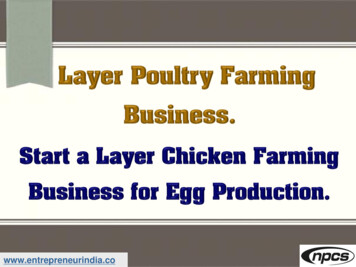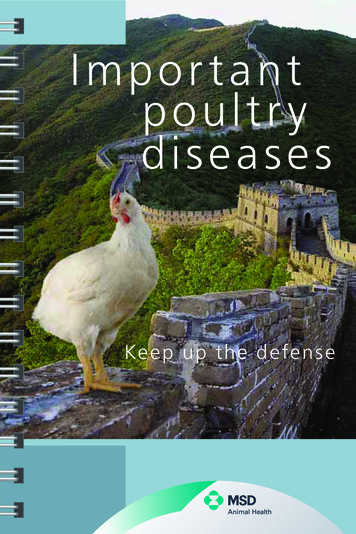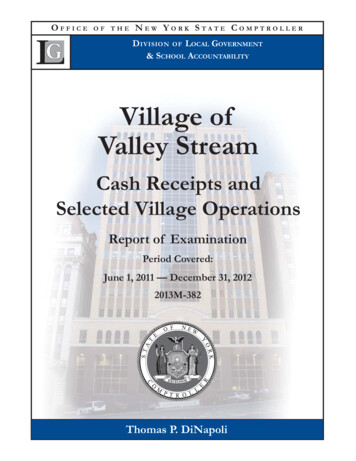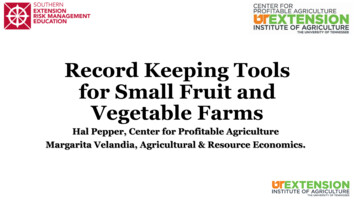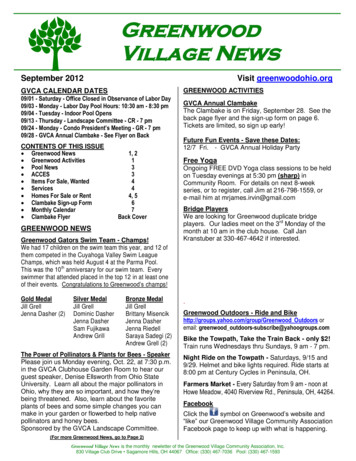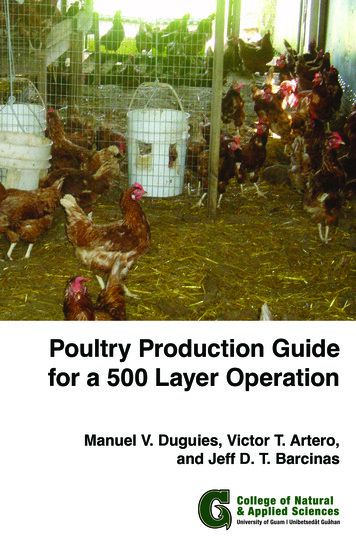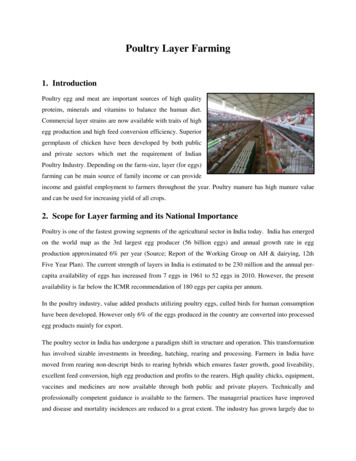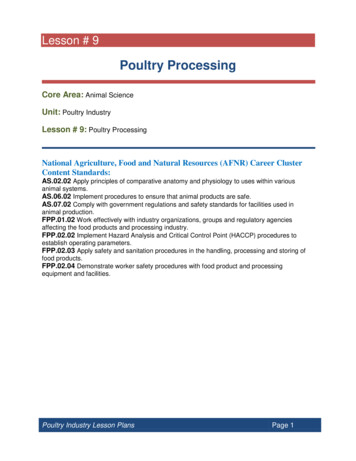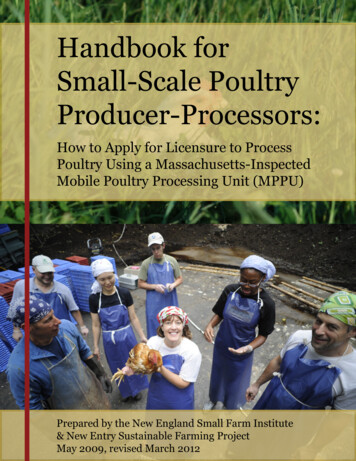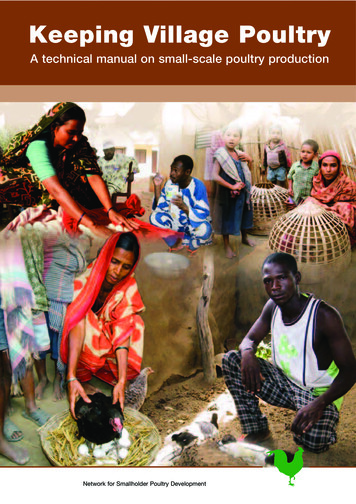
Transcription
Keeping Village PoultryA technical manual on small-scale poultry productionNetwork for Smallholder Poultry Development
Table of ContentsTable of .Feeding334.Diseases and Health Management505.Profitability and marketing of products666.Animal selection and breeds78AnnexesA. Additional material85B. International Poultry Networks88
IntroductionNeed for a manual on small-scale village poultryThere is a growing attention and interest in using poultry as a tool in povertyalleviation in villages throughout the world. However, the existing literature eithergives advice on industrial or semi-industrial production systems using exotic(imported) breeds under highly controlled conditions, or very simple field guidesgiving little useful advice on how to rear poultry at village level. The present manualtries to gather existing knowledge on how to improve village poultry productionsystems with relatively few inputs. The manual will deal with improved free-rangesystems consisting of small flocks of 5- 50 local or cross-bred chickens. Small-scale confined poultry rearing, sometimes also called small-scale industrial poultryproduction will not be dealt with in the present manual. The main reason behindthis choice is the fact that many excellent practical handbooks and guidelinesdealing with such systems already exists. Please consult Annex A for titles onmanuals and books relating to small-scale industrial poultry production, as well asreferences for relevant training manuals dealing with improved free-range systems.In Annex B, you may find a short introduction to the three major internationalnetworks on small-scale village poultry development.The primary target group of the manual is extension workers in the government andprivate sector involved with smallholder poultry development at village level. Asecondary target group is literate small-scale poultry farmers. It is the intention thatextension workers and literate farmers should themselves be able to extract thematerial they need from the manual and reuse it in their specific contexts.Need for a participatory approachWhen instructing villagers in improving poultry management and production, it isimportant that the training takes place in a participatory manner. Involvement andlearning are enhanced when the participants contribute to the discussion. It istherefore essential that the participants are encouraged to come forward with theirown experiences, and that the discussions take their point of departure in recordsof local practices and problems. Likewise, practical instruction, where theparticipants prepare equipment out of local materials, mix local feeds etc., highlyincreases their ability to remember what they have learned. The participatorymethod and learning-by-doing will create a direct connection between the trainingand the challenges the farmers encounter when implementing new methods. Pleaseconsult the separate Poultry Network manual on Farmer Field Schools for moreadvice and ideas on how to use the technical advice in practical training at farmlevel.Page 3
IntroductionIntroduction to technical chaptersThe manual has been divided into six chapters dealing with 1) Poultry Management,2) Housing, 3) Feeding, (4) Diseases and Health Management, 5) Profitability andMarketing of products, and 6) Animal and breed selection. Each chapter will presentbackground information and possible solutions to practical problems in the everyday management of small-scale poultry production under village conditions in thetropics.AcknowledgementsThe authors would like to acknowledge the support and ideas given by resourcepeople involved in rural poultry development Worldwide. A first draft of the manualhas been tested in several countries supported by Danida through AgriculturalSector Programme Support (ASPS) or NGO supported agricultural developmentactivities. In Vietnam, Dr. Jens Peter Tang Dalsgaard, ASPS livestock advisor, hiscolleagues and local technical advisors have given fruitful feedback on techniquesand training issues. In Benin, Dr. Christophe Chrysostome, FSA-UAB and hiscolleagues have tested several techniques and approaches and given us valuablefeedback. In Bangladesh, Burkina Faso and Senegal rural development effortssupported by Danida under different development programmes and projects haveprovided us with useful information on technical as well as training issues. InDenmark, the Danish Poultry Network has received important critique from poultrydevelopment experts Mr. Hans Askov Jensen, Mr. Peder Lund, Mr. Peter Wollesenand Dr. Hans Ranvig. Finally, Dr. Emmanuelle GuerneBleich, Dr. Manuel Sanchez andDr. Simon Mack from AGAP/FAO gave important feedback and advice on the firstdraft and supported us in terms of access to previous training material anddrawings published through the UN system.If you find that certain paragraphs or chapters should be changed or new issuesadded, please do not hesitate to contact the Network for Smallholder PoultryDevelopment on our e-mail: poultry@kvl.dk.Copenhagen, DenmarkSeptember 2004Jens Christian RiiseAnders PerminCharlotte Vesterlund McAinshLone FrederiksenPage 4
Chapter 1 ManagementVillage-based poultry production systemsNearly all rural and peri-urban families keep a small flock of poultry. These aremostly owned by women and managed by women and children. Profits are usuallylow and products are used for home consumption, as gifts and for religiouspurposes. Village-based poultry production systems may be divided into at leastthree different categories (Table 1.1) i.e., A: traditional free-range, B: improvedfree-range and C: small-scale confined rearing systems. The aim of this manual isto suggest different interventions which may help the farmer to move from A to B,that is, to improve the traditional free range system into what is often called a“semi-scavenging system” .The small-scale confined systems, also called smallscale industrial poultry production, has been dealt with in several other handbooksand manuals, and will not be dealt with in this manual. Annex A gives references toa number of valuable publications relating to small-scale confined systems.Table 1.1 Village-based poultry production systems.A: Traditional free-rangeB: Improved free-rangeC: Small-scale confinedLow input/low outputLow input/low outputHigh input/high outputMajority of rural familiesModerate number of ruralFew rural familiesOwned mostly by womenOwned by women & familyBusinessmen(1-10 birds)Home consumption(5 – 50 birds)familiesHome consumption and saleon local markets(50 – 200 birds)Family incomeBusiness incomeSocial & cultural importanceSocial importanceLittle social importanceIndigenous breedsIndigenous/ improved breedsHybrids (broilers or layers)Small cash income(gifts, religious)High mortalityNo feeding (scavenging)No vaccinationNo medicationNo housingEgg production: 30-50eggs/y/henLong broody periodsGrowth rate 5-10 g/dayMicro-creditModerate mortalityLocal feeds (semiscavenging)Newcastle DiseasevaccinationLittle medication/localremediesCredit based on assetsLow mortalityBalanced feedsSeveral vaccination schemesFull medicationHouses with cages or deeplitterEgg production: 250-300Simple housingeggs/y/heneggs/y/henGrowth rate 50-55 g/dayEgg production: 50-150Short broody periodsNo broodinessGrowth rate 10-20 g/dayPage 5
Chapter 1ManagementDue to the complexity of the systems, there are many ways of improving poultryproduction of which the most important are reflected in the titles of the chapters ofthis manual, i.e. management, housing, feeding, disease and health management,marketing and breed and animal selection.A. Traditional free-range poultry productionThe present situation in many villages is that poultry is left with little or no care.This causes severe fall in productivity. The birds find their feed by scavengingamong the houses in the village, and in addition they might get leftovers from theharvest and from the kitchen. As a result, feed is rarely adjusted to the needs of thebirds. Young chicks are left scavenging together with adult birds, having to competefor feeds and becoming easy prey for predators and spread of diseases.Very often birds do not get enough water, or they get dirty water, which maytransfer diseases. Birds are seldom put in an enclosure or a shelter to protect themfrom wind and rain, or to keep them safe from predators and thieves. Nests for hensare rarely provided, causing the birds to lay their eggs on the ground. Furthermore,the system is usually based on hens with an ability to go broody and rear their ownchicks. This has many advantages, but the long broody periods reduce eggproduction. Birds are seldom vaccinated or given medicine against diseases orparasites, as this is not seen as being profitable. Different poultry species are kepttogether and animals bought in the market or other villages are mixed with theflocks.Consequently many birds die very young, due to predators, diseases, starvation,adverse weather conditions, and accidents. Often eight out of ten chicks die withinthe first few months.Page 6
Chapter 1ManagementFig. 1.1 Poorly managed poultry farmMany birds may get ill and grow slowly, producing fewer eggs and less meat. Birdsthat roam everywhere may easily catch and spread diseases. When one bird has acontagious disease, there is a greater risk that all birds in the village will get it. Ifthere is a general lack of essential nutrients, resistance against diseases is low.Village poultry production often encounters problems related to lack oforganisation, which implies that local inputs, such as feed, medication, veterinaryservices, and training, are rarely available locally. Without organisation andknowledge about the potentials of village poultry, the abscense of an enablingenvironment, the farmers, mostly women, receive very little support and advice fromeach other or from extension workers. As a consequence village-based small-scalepoultry production remains rudimentary in most places.Poultry behaviourNormally village poultry form small groups consisting of 5-10 hens with one cock,but flocks may vary from one up to around 30 adults and young growers, dependingon the feed resource base and disease level in the area. Up to this number they willstill be able to recognise each other, which will help diminishing conflicts among thebirds. Each cock or hen in the flock enjoys his or her special status in relation to theothers, implying that some have priority over others when choosing places forPage 7
Chapter 1Managementnesting, for resting, for scavenging, etc. High-ranking animals will have nicefeathers and combs, and their posture will show their dominant position. If a lowranking hen comes too close to the territory of a hen of higher rank, the latter willindicate this by stretching her neck and turning her bill towards the intruder.Normally this will suffice for the other to retire. The ranking may change accordingto age, brooding, and other factors. The system of more or less stable dominance isvery practical, since the animals can be free to concentrate on finding food andwatch out for enemies.Poultry have a very constant rhythm day in and day out. In the early morning andlate afternoon they scavenge for food. Later in the morning the hens will often layeggs, and after midday they will rest. When they sleep at night, they prefer to sithigh in order not to be easy preys for predators.Fig 1.2 Dust bathing is important for poultry to keep clean.To protect against very high or low temperatures and to be fit to escape predators,it is important for birds to have good feathers. They therefore spend much timecleaning and preening their feathers with their beaks. In order to protect themselvesagainst external parasites, they dust bathe several times each day (Fig. 1.2).B. Improved free-range poultry rearingA village hen often weighs no more than 1.2 – 1.5 kg at the point of lay. A villagecock weighs maybe 1.4 – 2.0 kg at age of maturity. Poultry need a good supply ofvaried feed and of clean water. Depending on the time of the year they will be ableto find part of their feed by scavenging in the surroundings of the household. Butoften they will need an extra supply of nutrients in order to gain weight and forhens to lay a good quantity of eggs. Especially the small chicks need good proteinrich feeds such as balanced feeds or from simple supplementary sources such asmaggots, snails, termites etc. (see chapter 3 for more advice on feeds and feeding).Page 8
Chapter 1ManagementOften a free-range hen will lay the first eggs at the age of 22-28 weeks and lay 3-4clutches of 10-15 eggs a year, depending on season, and in particular availability offeeds. A hen will often find a dark, quiet place for laying eggs and for brooding. Shedoes not want to be disturbed by the others, and she wants to feel safe frompredators and passers-by. Unfortunately, many eggs go bad before they arehatched, because of disturbance, lack of nests, and annoying ecto-parasites makingthe hen leave the nest frequently, with resulting low hatchabililty.After 21 days of incubation remaining eggs will hatch. Most free-range poultrykeepers will let young chicks follow the mother hen immediately after hatching. Theresult is very high chick mortality during the first weeks of age, mainly due topredation by eagles and snakes, drowning, from road accidents and general chickexhaustion.Flock managementIn general, it only takes a little continuous attention every day to improve your freerange poultry production. But before starting, it is highly advisable to makecalculations of whether the enterprise will be profitable or not. For further advice onhow to calculate inputs and outputs and to assess the risk, please see chapter 5 onMarketing.Fig. 1.3 An example of simple housing for up to 5 hens (Night basket)Page 9
Chapter 1ManagementFig. 1.4 An example of a simple house for a flock of 10-20 birds in SenegalA simple night-basket or chicken house or (Fig. 1.3 and 1.4) will diminish the risk ofloss because of bad weather, predators and thieves. Inside the house the birds needperches to sit on when they sleep. If you put the nests inside the house as well, it iseasy to find the eggs, and the hens will not be disturbed.For table egg production, you only need hens. However, some farmers keep onecock with the hens to watch for predators and to facilitate the pecking order, thusminimizing conflicts within the flock. To produce fertile, hatchable eggs, you willneed one cock for approximately 10-15 hens. When surplus cocks reach amarketable size, they should be sold, slaughtered, or given away as presents, toprevent the cocks from eating the scarce feed resources, as well as fighting andstressing the hens (Fig. 1.5). You may easily recognise young cocks by their tailfeathers, their comb, and their general (aggressive) behaviour and appearance incomparison to the hens.Page 10
Chapter 1ManagementFig. 1.5 Undesirable cock-fighting may be avoided by selling of young cocks.Always take into consideration that the size of the flock should match the size ofthe house, the amount of feed you can afford to buy and the feed resources in theenvironment (scavenging feed resource base). Additional advice on housing andfeeding may be found in chapters 2 and 3.Do not buy animals at the market from uncontrolled sources, especially not duringperiods when outbreaks of diseases are common. They may introduce contagiousdiseases into your flock.Vaccinate all birds against Newcastle Disease and other prevailing diseases such asFowl Pox on a regular basis to prevent high mortality. Small chicks should bevaccinated against the common contagious diseases at the age of 2-3 weeks. Revaccination should always be performed according to the instructions (see chapter 4on disease and health management for further advice).In case of serious diseases you should slaughter the bird (it can be eaten if cookedwell), call the veterinarian, or use drugs if you feel absolutely sure that you know thedisease. If you do not kill it the bird at once, it must be separated from the others.Sick birds (or parts from sick birds) should be burned or buried deep enough toavoid that dogs and other animals dig them up and spread the disease. If you havemany sick animals, do not introduce new birds, and do not vaccinate.Page 11
Chapter 1ManagementFig. 1.6 A separate shed may be necessary to isolate ill or newly purchased birds.Before introducing new birds to your flock, you should keep them isolated for one totwo weeks (Fig. 1.6).Fig. 1.7 Careful observation of the flock on a daily basis is important.Daily rhythm and careful observationPage 12
Chapter 1ManagementIt is very important to spend some time each day observing every animal carefully(Fig. 1.7). In this way early signs of disease, malnutrition, or other problems may bediscovered, and the necessary precautions taken. Knowing each hen will also helpyou choose eggs from the best hen for hatching, so that the chicks may inherit herqualities.Eggs for sale or hatching should be collected in the morning and again in theevening. In this way they will not be dirty or crack when the hens sit on them andthe hens will not be so tempted to brood as when there are many eggs in the nests.Eggs should be stored in a cool and humid place until sale or brooding.In order to prevent internal as well as external parasites a good hygiene is a must(Fig. 1.8). So every day the feeders and drinkers should be washed, and the houseand the nests must be cleaned for droppings, insects etc. Put fresh straw or hay inthe nests weekly. Adding a little ash on top may help prevent parasites (see chapter2 for nest management).Fig. 1.8 Every day the house, feeders and drinkers should be cleaned carefully.At least once a year, and always after serious outbreaks of diseases, the house,perches, and nests should be disinfected by thorough cleaning and lime-washing(fig. 1.9). Alternative ways of disinfection, e.g. smoking, may be used but are lessPage 13
Chapter 1Managementeffective. If problems persist in small wooden cages or houses, they should finallybe burned, and a new house built, as parasites may hide in even the smallest cracks.Fig.1.9 Lime-washing the inside of the house for disinfection.The birds should always have access to a dry place for dust bathing. If they prefer acertain place, you may add a little sulphur or ash against the parasites.You may encounter problems with hens pecking each other, but mostly in flockswith high density, or if you keep local birds inside during the day. Wounds frompecking should be treated immediately to avoid cannibalism in the flock.Fig. 1.10 Pecking often occur if local birds are kept inside for days.Page 14
Chapter 1ManagementIt is advisable to keep records of your production. This will make it easy for you tosee successes and problems at an early stage. See chapter 5 for advice on recordkeeping.Feed and waterTo produce well and have good resistance against diseases, birds need adequatequantities of good quality feed. See Chapter 3 for more advice on feeding andwatering. Supplementary feed and clean water should be given at least early in themorning and again in the evening when the birds are returning to the house for thenight. It is important that the feeders and drinkers are kept clean, so that infectionsdo not spread through dirty feed and water.Fig. 1.11The drinker and feeder should be carefully cleaned early morning and lateevening to avoid spreading of diseases.Young chickens should be fed separately from the adult birds (Fig. 1.20B) They willoften have a special diet, and it is best for them not to have to compete with theadults for food. It is very important for small chicks always to have access to cleanwater, as they may easily die from dehydration. There is more information onmanagement of young chickens later in this chapter.Page 15
Chapter 1ManagementLaying hensHens start laying eggs at the age of 22-32 weeks, depending on the breed, theirhealth, and development. Often indigenous hens will start much later than imported(exotic) breeds. Hens around 40-50 weeks of age lay the most eggs, and thengradually their egg production decreases slowly. If a mature hen lays very few eggs,you should sell or eat it. In small flocks, it is relatively easy to check whether thehens are laying eggs or not (Fig. 6.4). Laying hens should have easy access tocalcium rich food that may be supplemented by calcium-rich sources such ascrushed snail or egg shells.Provide nests in the hen house for laying. This way it is easier to find the eggs, andthey can be kept clean. In order to teach the hens to lay in the nests, you may placea couple of eggs or stones looking like eggs in the nests. If you mark the eggsproperly, you will know which eggs are new and should be collected. When hens gobroody and sit on the eggs, they always stop laying. By collecting eggs several timesa day, you may avoid that the hens become broody. If a hen goes broody, and youdon’t want her to, separate her immediately from the rest. You may for exampleisolate her in a small cage in a cool place, without access to nest material for a fewdays (Fig. 1.12).Fig. 1.12 If you do not want a hen to go broody, separate her from the rest.Page 16
Chapter 1ManagementDo not hatch new chicks if you don’t have enough feed for them. If you hatch toomany chicks, they may die from starvation or malnutrition, or their resistance todiseases may be reduced.Natural incubation and hatchingFor chickens it takes 21 days for eggs to hatch, for ducks it takes 28 days.Eggs should be fresh before incubation. The age of eggs should be no more than 10days, when stored at temperatures below 20º C. If the temperature is higher, theeggs should be no more than 5 days old. To obtain the best incubation result, theeggs selected for incubation should be of average size and normal shape for thebreed. Further, the eggs should have a smooth uncracked shell. If there are cracksin the shell, the loss of moisture from the egg can be too high and the embryo maydie. There is also a risk of bacteria entering the egg, which may lead to unhealthy ordead embryos. Store the eggs in a cool and humid place until incubation, forexample in a box in a hole in the floor of the coolest part of the house. Eggs for salemay also be stored in the same place. During incubation you should always check,which eggs are fertile and which are non-fertile. Fertile eggs very quickly developblood vessels, which may be seen against a sharp light from a torch (See figures1.13 and 1.14).a.b.Fig. 1.13 Home-made candlers using either your hand or a wooden box, and a torchPage 17
Chapter 1ManagementFig. 1.14 Identification of infertile eggs (a), fertile eggs (b) and eggs with deadembryos (c)After 7-10 days of incubation the eggs can be candled and the infertile eggs andeggs with dead embryos can be removed from the nest. Figures 1.13a-b shows twosimple candlers and figure 1.14 shows how fertile eggs, infertile eggs and eggs withdead embryos are identified at the age of 7 days. When candling, a fertile egg hasvisible blood vessels and a dark spot that is the embryo. The blood vessels can bemore or less developed depending on how strong the embryo is. If the embryo isdead, it is seen as a ring of blood around the embryo. An infertile egg has anenlarged air cell and the yolk causes and obvious dark area in the egg. It isimportant that infertile eggs and eggs with dead embryos are removed from thenest as they will decompose and may break and spoil the fresh eggs underincubation.Fig. 1.15 Bad situation for the brooding hen: The hen is disturbed by others. She does not have access to feed and water. The nest is full of parasites disturbing her. The result is few eggs being hatched and a low survivability of the hatchedchicks, who easily get ill and die.Page 18
Chapter 1ManagementFig. 1.16. A good situation for the brooding hen: The hen is left alone with access to feed and water. The nest is well-managed with clean hay and antiparasitic remedies. She leaves the nest only shortly to drink and feed. The result is a high hatchability and healthy and lively chicks with a highsurvivability.A broody hen should be separated from the flock to prevent other hens fromdisturbing her (fig. 1.16). Keep the hen in a separate nest with free access to freshwater and feed within a short distance. Provide the hen with a brooding nest orbasket big enough to contain all her eggs. Put fresh hay or straw in the nest and addsome ash to prevent parasites. Add more eggs from other nests until she hasenough according to her size.In the dry and hot season, you may spray the breast of the hen with water toincrease the humidity around the eggs. The hen will do the work of hatchingperfectly if she has the right conditions, for example a clean and suitable nest andquiet surroundings.If only small quantities of chicks are to be hatched, a free-range hen is a betterbrooder than an artificial incubator, as she will normally have a higher rate ofhatching (80-100%) than an incubator (60-80%).After hatching and until the chicks are old enough to be on their own, usuallyaround 4 weeks of age, the hen will directly protect the chickens from adverseweather conditions and predators by covering them with her wings. Indirectly, thehen will protect the newly hatched chicks against diseases for the first two weeks;and slowly transfer her natural behaviour to the chicks. Natural behaviour meansknowing how to search for food and water; which feed to take and which to avoid,how to avoid predators by hiding or seeking shelter in bushes and trees, how tokeep healthy by dust bathing, etc.Page 19
Chapter 1ManagementManagement of small chickens (basket system)In hot climates, the best and cheapest method to guard the small newly hatchedchicks is the so-called “basket system” (Fig. 1.17). Small chickens should be keptwith their mother overnight in a so-called night basket, i.e. a round conical cagewith a floor, see figure 1.3. A night basket may be made from bamboo or thinpieces of wood. Dry cut straw, rice husk, saw dust or shavings of 8-10 cm depth canbe used as litter. In the morning, the chicks should be removed from the nightbasket and kept in a day basket, which is a bottomless conical cage, see figures1.17 and 1.18. A dry jute or straw mat should be placed in the cage if the soil isdamp or wet. The day basket should be moved to a new clean spot every day toavoid diseases. The night basket is closed in order to prevent predators fromentering and in order to keep the hen and chicks warm at night.Fig. 1.17 A day basket with a jute mat, a feeder and a drinker.The basket can easily be moved around. The day basket needs to be bigger andmore open in order for the chicks to move around without the hen stepping on themand in order to secure good ventilation. There has to be room for a small feeder anddrinker. When the weather is hot, the chicks often do not need extra heat, but theyshould be protected against wind and rain.Page 20
Chapter 1ManagementFig. 1.18 Management of small chickens using the day basket systemThe basket system may be used according to the following schedule pictured in fig.1.18:A: 0-1 week of age:Keep the hen with the chicks from 4-7 days to protect them and to adjust thetemperature. She will know exactly how to adjust the temperature according to thesound of the chicks. Make sure there is easy access to clean water and high-proteinfeed for the chicks. Ensure that the basket is kept clean, by removing droppings andspilled feed on a piece of paper or a woven mat placed beneath the basket.B: 1-3 weeks of age:Keep the chicks in the cage all the time, but let the hen out for scavenging duringthe day. She should be able to hear the chicks from where she moves. If she wantsto enter the cage, she should be allowed to do so. Make sure there is easy access toclean water and high-protein feed, and ensure that the basket is kept clean at alltimes. Keep hen and chicks together during the night.Page 21
Chapter 1ManagementC: 3-6 weeks of age:Keep hen and chicks together during the night, but gradually let the chicks out forscavenging with their mother during daytime. At first, only for a few hours duringthe morning, and then gradually a little longer. Make sure that the chicks still haveeasy access to clean water and high-protein feed under the basket, but that theentrance is too small for older birds to enter. Ensure that the basket and the groundare kept clean at all times.D: After 6 weeks:Remove the basket system, and let the chicks scavenge freely together with themother hen. Give supplementary feeding in the evening for the whole flock,according to their needs (se chapter on feed).Ten simple rules for better management1. Provide simple houses or shelters and perches inside houses;2. Use day baskets during day and night basket during night;3. Give unlimited access to clean water;4. Separate young chicks from adults, when they are fed;5. Control the birds’ health daily;6. Apply vaccines regularly according to the advice of local vaccinators orveterinarians;7. Isolate a bird when it becomes ill, - call the veterinary assistant or kill thebird;8. Kill or sell non-productive birds, i.e. cockerels and old hens that havestopped laying;9. Provide nests, and control nests for eggs two times a day;10. Check the reproduction status of each hen once a month, and give extra careto hens that are brooding.Page 22
Chapter 2 HousingWhy should poultry have houses or shelters?Housing is essential to protect against predators, thieves, rough weather (rain, sun,very cold winds, dropping night temperatures) and to provide shelter for egg layingand broody hens. A suitable or comfortable poultry house is also important forefficient production and convenience of the poultry farmer. In the following, we
Introduction Page 3 Need for a manual on small-scale village poultry There is a growing attention and interest in using poultry as a tool in poverty

